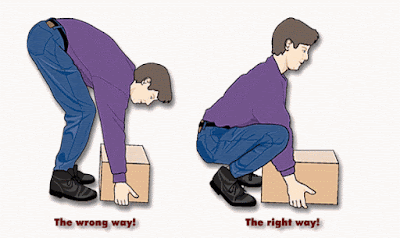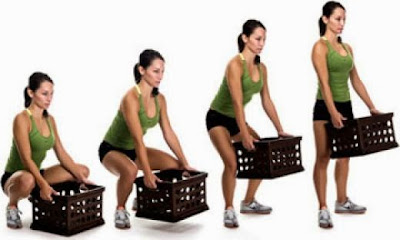Lifting of objects can range from very light objects such as a piece of paper, a pin or a pen to very heavy objects like loads of boxes. Lifting is very much a part of our every day jobs. And, because it is something we do so often, we tend to do it without thinking, or at least we do until we strain a muscle, or worse, hurt our backs.
Lifting incorrectly can result in a variety of injuries. Back strain is a very common one. It results from over-stretching certain muscles, but it can be avoided by practicing safe lifting techniques. A hernia is another injury associated with lifting. A hernia does not generally result from a single lifting effort. It is usually the result of continued extreme exertion, especially done contrary to the structure of body.
Don't underestimate the importance of being in good physical condition. Years of poor posture, overeating, lack of exercise, stress and improper lifting can catch up with you. Learn how your back works and what you can do to keep it strong. Ask for your physician's recommended stretching, warm-up, and reconditioning exercises; then practice them regularly.
Safe lifting plays an important role in keeping your back healthy. Although there doesn't seem to be just one right method to lift an object, there are lifting techniques that take strain off the low back area.
These techniques have several steps in common. They recommend you "size up the load". That is, look it over. Decide if you can handle it alone or if you need help. When in doubt, ask for help. Moving a box or other object that is too heavy for one person is not worth strained and sore back muscles.
You should also "size up the area". Look over the area where you are carrying the object to, and make sure it is clear of obstacles before beginning to carry the object.
For that period of time spent lifting, the load becomes a part of your body. You support and propel the object while it is attached to you. This attachment should be firm and sure. Get a good grip.
Attaching yourself to a load will change your balance. To keep this change of balance to a minimum, keep the load close to your body, to your normal center of gravity between the legs, between the shoulders.
Attaching yourself to a load will change your balance. To keep this change of balance to a minimum, keep the load close to your body, to your normal center of gravity between the legs, between the shoulders.
Good foot position allows you to keep your balance and bring into play the full power of your leg muscles. Leg muscles are more powerful and more durable than back muscles. Let your leg muscles do the work. Again, footwork is important once you avoid twisting your upper body. Use your feet to change direction. Don't twist your body. Twisting compounds the stress of the lift and affects your balance.
When you have someone helping you lift an object, teamwork becomes important. If you're going to be carrying the load to another point, both of you should decide in advance how it is to be handled. Check the route and clearance. One person should be the leader and be in a position to observe and direct the other. Lifting and lowering should be done in unison. Don't let the load drop suddenly without warning your partner.
Everyone has a way of lifting that seems most natural. Examine yours to see if you are using lifting techniques that reduce strain on your lower back. As the employee making the lift, you're being counted on to make lifts that are safe and comfortable for you based on the items we've discussed:
- Size up the object – is it too heavy or awkward in shape or size?
- Consider asking for assistance or using suitable equipment (eg trolley).
- Consider achieving the “lift” by performing several smaller safe lifts, rather than one unsafe lift.
- Stand close to the object
- Keep your arms and elbows close to your body.
- Bend with your knees don’t stoop.
- Position your feet shoulder width apart or with one foot ‘beside’ and the other foot ‘behind’ the object.
- Maintain a “long” spine. (Think about a line that goes from your head through your spine all the way down to your tail bone)
- Tighten your abdominal core stability muscles.
- Use your thigh and buttock muscles to lift the load
- Don’t twist while carrying the object. To change direction, shift your foot position and turn your entire body.
- Avoid lifting after prolong sitting or forward bending (eg long drives or weeding the garden).
Check out a You Tube Video of safe lifting on the link below:
Think safe - work safe - live safe
Think safely in everything you do
Safety First

















